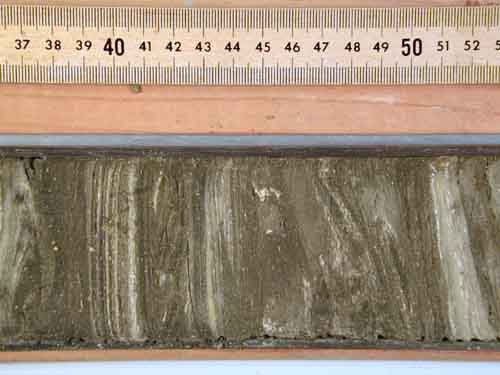|
Data & Samples > Core Samples > Gulf Coast Repository >
GCR Display Cores
Section 112-686B-5H-4

Location
Peru Continental Margin
Regional setting
Two processes,
plate subduction and coastal upwelling, shaped the Peruvian margin and its
sediments since Eocene time. Studies of theses two processes off South America
increased our general knowledge of subducting plate boundaries and the dynamics
of coastal upwelling.
Site objectives
- Obtain a high-resolution record of upwelling and climatic histories from Quaternary and possibly Neogene sediments;
- Calculate mass accumulation rates of biogenic constituents from an upwelling regime; and
- Document in detail early diagenetic reactions and products specific to the coastal upwelling environment.
Lithology
Diatomaceous mud finely laminated with thin graded base, slump folds, convolute laminations, microfaults, and dewatering veins.
Age
Quaternary (based on volcanic ash layer)
Depositional Environment Interpretation
Sediments deposited in middle to upper-bathyal environments, perhaps a slope
depths comparable to the present depth of site 686 (205.7 mbsf). Higher energy,
more-oxygenated environments having substantial terrestrial influx and enhanced
sediment reworking relative to units I, III and V.
Based on diatoms evidence, this section corresponds to one of
the three prolonged phases of intense coastal upwelling identified in the
Quaternary section drilled at Site 686.
Diatomaceous laminated muds intervals alternate with
bioturbated diatomaceous muds and they may indicate sea level fluctuations and
the position and intensity of the oxygen-minimum zone.
| 
